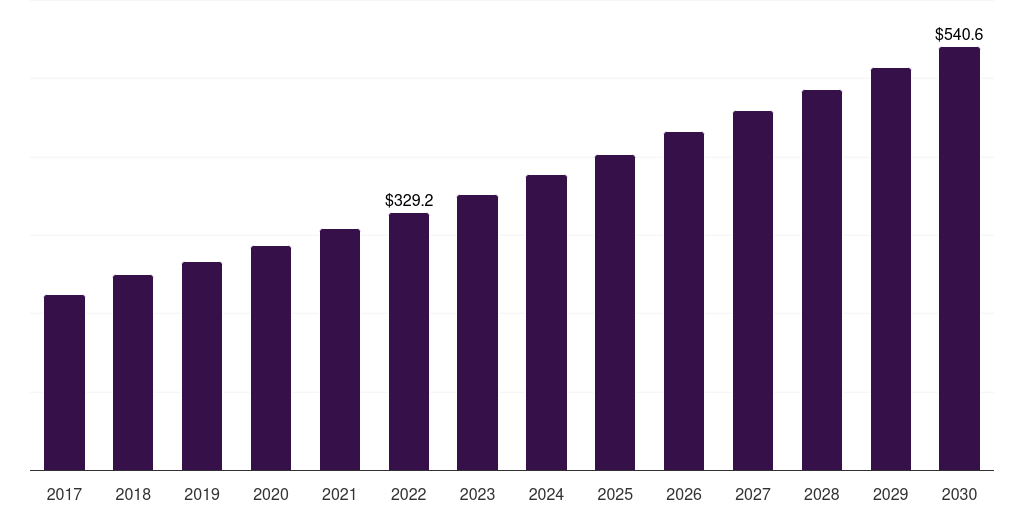U.S. Insect Repellent Market Size & Outlook, 2022-2030
U.S. insect repellent market, 2017-2030 (US$M)

Related Markets
U.S. insect repellent market highlights
- The U.S. insect repellent market generated a revenue of USD 329.2 million in 2022 and is expected to reach USD 540.6 million by 2030.
- The U.S. market is expected to grow at a CAGR of 6.4% from 2023 to 2030.
- In terms of segment, mosquito repellent was the largest revenue generating insect type in 2022.
- Mosquito Repellent is the most lucrative insect type segment registering the fastest growth during the forecast period.
Insect repellent market data book summary
| Market revenue in 2022 | USD 329.2 million |
| Market revenue in 2030 | USD 540.6 million |
| Growth rate | 6.4% (CAGR from 2022 to 2030) |
| Largest segment | Mosquito repellent |
| Fastest growing segment | Mosquito Repellent |
| Historical data | 2017 - 2021 |
| Base year | 2022 |
| Forecast period | 2023 - 2030 |
| Quantitative units | Revenue in USD million |
| Market segmentation | Mosquito Repellent, Bugs Repellent, Fly Repellent |
| Key market players worldwide | Reckitt Benckiser Group PLC, Godrej, Dabur India, Johnson & Johnson, Spectrum Brands Holdings Inc, Henkel AG & Co KGaA, Jyothy Laboratories, Coghlan’s, SC Johnson, Sawyer Products |
Other key industry trends
- In terms of revenue, U.S. accounted for 6.8% of the global insect repellent market in 2022.
- Country-wise, China is expected to lead the global market in terms of revenue in 2030.
- In North America, U.S. insect repellent market is projected to lead the regional market in terms of revenue in 2030.
- Canada is the fastest growing regional market in North America and is projected to reach USD 151.0 million by 2030.
Mosquito repellent was the largest segment with a revenue share of 48.63% in 2022. Horizon Databook has segmented the U.S. insect repellent market based on mosquito repellent, bugs repellent, fly repellent covering the revenue growth of each sub-segment from 2017 to 2030.
DEET, scientifically known as N, N-diethyl-meta-toluamide, functions as the primary active component in numerous insect-repellent formulations in the U.S. Its prevalent use centers around deterring biting insects, notably mosquitoes and ticks.
The CDC has approximated that around 30% of the American population relies on DEET-containing insect repellents to safeguard against mosquito and other insect bites. These measures are particularly relevant in the context of ticks, which are carriers of Lyme disease.
According to a June 2023 article in TIME Magazine, approximately 198 million Americans used insect repellents in 2022. This can be primarily attributed to the escalating severity of tick seasons with each passing year.
No credit card required*
Horizon in a snapshot
- 30K+ Global Market Reports
- 120K+ Country Reports
- 1.2M+ Market Statistics
- 200K+ Company Profiles
- Industry insights and more
Insect Repellent Market Scope
Insect Repellent Market Companies
| Name | Profile | # Employees | HQ | Website |
|---|
U.S. insect repellent market size, by insect type, 2017-2030 (US$M)
U.S. Insect Repellent Market Outlook Share, 2022 & 2030 (US$M)
Related regional statistics
Sign up - it's easy, and free!
Sign up and get instant basic access to databook, upgrade
when ready, or enjoy our
free plan indefinitely.
Included in Horizon account
- 30K+ Global Market Reports
- 120K+ Country Reports
- 1.2M+ Market Statistics
- 200K+ Company Profiles
- Industry insights and more


